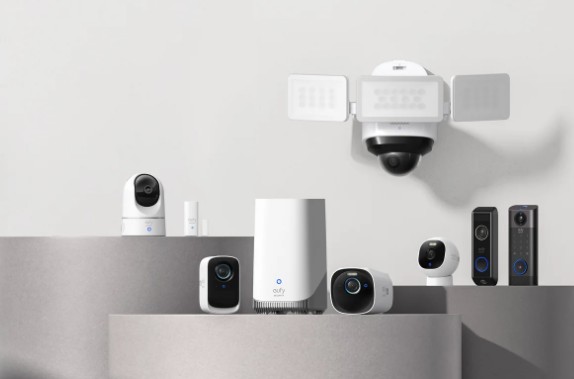
Security cameras must be carefully placed to secure your property. Cameras cannot cover every inch; thus, position is crucial. Focusing on access points and several paths reduces blind spots and deters invaders. Full coverage needs distinct considerations for outdoor and interior settings. The correct system monitors and prevents crime. This article demonstrates how to position cameras for optimal security and peace of mind. To plan your security system, consider your property's layout, visibility, and lighting.

Where to Place Outdoor Security Cameras?
Front Door - Your First Line of Defense
More than one-third of burglars enter through the front entrance, making it a common camera target. A camera should be high enough to prevent tampering yet low enough to capture facial characteristics. It might face the doorway or dip downhill. To protect the camera from the elements, place it under the eaves of a covered porch. Consider installing a smart doorbell for additional functionality. This gives both proof and visual discouragement. To watch activities near your front entrance, make sure your camera supports night vision and motion detection.
Driveways and Garages - Overlooked But Essential
Driveways and garages are typically used to store autos and tools while also providing access to your home. A camera mounted here protects valuable things while simultaneously monitoring entry points. Install a camera that looks down at the driveway on the roof of your home or garage. To provide privacy, slant it so that it spans the full length without pointing toward neighboring houses. For detached garages, use a cordless or battery-powered camera. Motion-activated lighting can improve vision clarity at night. A conspicuous camera also deters shipment theft and damage. Integrating this setup into your total Home Security System ensures improved monitoring and more peace of mind for your family.
Backyard and Side Entrances - Cover Blind Spots
Backyards and side entrances are typical targets owing to their isolation. Install cameras at your home's back corners to monitor larger regions. Cover the fences, gates, and sliding doors. Mount them 8-10 feet high to prevent tampering. Choose wide-angle lenses to capture more space. Consider using weatherproof infrared cameras for nighttime coverage. Motion sensors can help reduce unneeded recordings. Although critical to perimeter coverage, these zones are frequently overlooked. Including them in your home security system safeguards susceptible areas that criminals target.

Where to Place Indoor Security Cameras?
Main Entry Points and Hallways
Inside cameras should monitor the main gateways and hallways. Identification of passageways to the rest of the home aids in the detection of burglars. Cameras at hallway ends or above doors offer a clear view. Place them away from furniture that might obstruct the lens. Select a view that includes the entryway and surrounds. Motion-detecting cameras and cloud storage provide automated notifications. These places verify break-ins and identify intruders. Combining them with external surveillance results in a dependable Home Security System.
Living Rooms and Common Areas
Living rooms commonly have devices and access points such as windows and sliding doors. Install cameras in corners to provide maximum coverage without affecting the décor. Place high but inconspicuous to deter tampering. Choose versions that provide two-way audio or smartphone connectivity for real-time monitoring. These places may also use cameras to monitor babysitters, pets, and suspicious activities. Keep them away from private areas to maintain household privacy. Track arrivals and departures to generate a movement timeline. Adding these zones to your home security system allows you to respond more swiftly to odd behavior.
High-Value Areas Like Safes or Offices
Home offices and bedrooms should include cameras to protect safes, paperwork, and expensive electronics. These sites are often attacked. Cameras in high corners may clearly capture the safe or storage room. To ensure your privacy, use encrypted and local storage. Reduce camera glare if the room has windows. Smart features such as remote access and timely notifications help you handle problems swiftly. Cameras prevent and aid other Home Security system design features.
How to Maximize Camera Coverage?
Optimal Camera Height and Angles
For best results, position cameras 8–10 feet above the ground. At this height, tamper resistance and vision are balanced. Lower the lens a little to avoid distortion while capturing facial characteristics. Don't use too many angles to hide important parts. It is best to protect indoor corners. Without obstructing views, position the outside cameras to face access points. During installation, check visibility in many areas. Test recordings will confirm details and illumination. Monitoring is made easier with a continuous camera array. Height and angle are basic yet essential to the efficiency of a home security system.
Avoiding Obstructions and Blind Spots
Walls, furniture, and trees may impede your camera's view. Before ascending, look for any potential impediments. Avoid putting cameras indoors near bright lights behind shelves. Trim outdoor bushes away from grills and fences. Wide-angle lenses provide greater coverage while distorting pictures. Check the video on a frequent basis to identify and correct blind spots. The camera position may change depending on your surroundings. Perfect monitoring demands good vision; thus, the design of a home security system is critical.
Using Motion Detection and Smart Features
Active smart cameras provide real-time alerts and connect to mobile applications. Motion zones help to reduce unintentional car and pet warnings. Two-way audio with visitors or intruders. AI and cloud storage enable faster film analysis. Connect cameras to a smart hub for centralized control. Record just when motion is detected to conserve bandwidth and storage. Smart features enhance reaction time and efficiency. These technologies turn ordinary cameras into reliable Home Security System equipment.
Conclusion
The location of security cameras is critical to home security. Concentrate on outer entrances, internal passageways, and valuables. Install cameras at the appropriate height, avoid barriers, and take advantage of smart features to optimize coverage. A well-planned arrangement reduces the invasion entrance sites. Consider your system to be layers of security, with each camera providing a shield. Keep an eye on your setup and make adjustments as needed to accommodate environmental changes. With thoughtful placement and modern technology, you can build reliable Home Security Systems that keep your property, loved ones, and peace of mind intact.